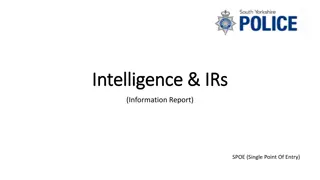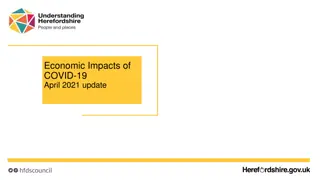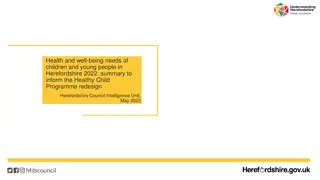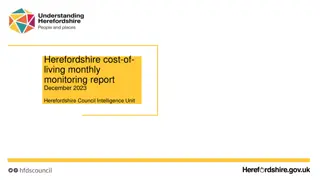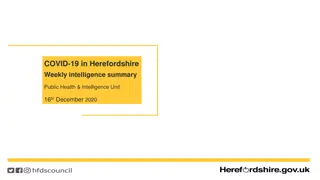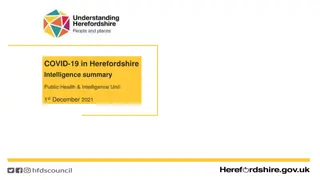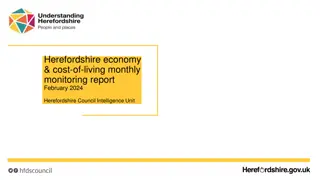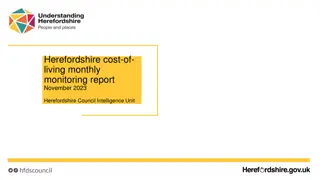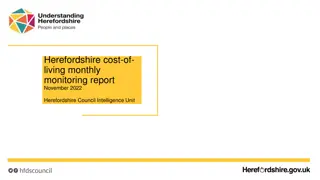COVID-19 Weekly Intelligence Summary in Herefordshire
Case rates in Herefordshire have significantly decreased, with falling numbers of COVID-19 patients in hospitals. Despite improvements, the county remains at level 5 on the local system rating, indicating high pressure on healthcare and social services. New cases continue to decline, with total lab-confirmed cases at 6,051. Testing demand is decreasing, while rates among different age groups have generally fallen. Deaths involving COVID-19 are increasing, with indications of higher-than-average mortality. Workplace transmission is becoming more prominent.
Download Presentation

Please find below an Image/Link to download the presentation.
The content on the website is provided AS IS for your information and personal use only. It may not be sold, licensed, or shared on other websites without obtaining consent from the author. Download presentation by click this link. If you encounter any issues during the download, it is possible that the publisher has removed the file from their server.
E N D
Presentation Transcript
COVID-19 in Herefordshire Weekly intelligence summary Public Health & Intelligence Unit 3rd February 2021
Contents 1. 2. 3. 4. 5. 6. 7. 8. Key messages (slide 3) COVID-19 testing (slides 4-5), COVID-19 cases (slides 6-8), including demographics (slide 9-10) and local areas (slides 11-12) Patients admitted to hospital (slide 13) Profile of deaths: published data (slide 14-15) Wider impacts national restrictions (slide 16) Effects of lockdown on population movement (slide 17) Other resources (slide 18) If you need help to understand this document, or would like it in another format or language, please contact us on 01432 261944 or e-mail researchteam@herefordshire.gov.uk
Key messages Although case rates have fallen considerably and we are starting to see a fall in number of patients with COVID-19 in hospital in the county, Herefordshire remains on level 5 (red) on the local system rating, with pressure high on primary and secondary care capacity and social services. Actions are being taken to prioritise core services. New cases continue to fall and average daily numbers are now one third of the peak in early January; and lower than the November peak. This mirrors the national picture, suggesting that the current lockdown is taking effect. The total number of lab-confirmed cases in the county throughout the course of the pandemic is now 6,051 (2 Feb). This is 283 more than for the same time last week a quarter less than the previous week (373). The 7-day case rate per 100,000 population reached 386 on 8 January, and is currently 145 (29 Jan) similar to mid December and lower than the November peak. Rates have generally fallen in all age-groups (including the young adults which had been driving the increases) and across all areas of the county. Despite halving in the last week, the rate amongst people aged 80+ remains relatively high. Demand for testing from symptomatic residents continues to fall, although 6,400 people had a lab-based PCR test in the week to 29 January. It s encouraging that the number that were positive has fallen to around 5%. Rapid lateral flow device (LFD) testing continues to increase as access expands. Published data on people in Herefordshire hospitals with Covid-19 shows that there were 83 inpatients on 23 Jan, a third less than the peak seen on 19 Jan. More recent local intelligence indicates that numbers are continuing to fall. Numbers of deaths involving Covid-19 continue to increase, with some indication that we are currently seeing a higher than average number of deaths for the time of year. 20 were included in the latest week s ONS data (occurring by 22 Jan and registered by 29 Jan). PHE data indicates that eight more have occurred since, which will appear in future weeks official counts. With cases still so high across the whole county, it isn t meaningful to attempt to report on outbreaks or situations at the moment. These are being monitored operationally, and there numbers are reducing. Transmission is becoming increasingly linked to key workers at social care and other workplaces, rather than the widespread community transmission seen during December and early January.
COVID-19testing: PCR tests and positivity The graph gives a complete picture of local PCR testing for Herefordshire residents, regardless of where or under which Pillar the test was carried out. Demand for testing continues to fall slightly, with 6,400 people tested in the week to 29 January. This is lower than last week and continues a falling trend in numbers of tests a pattern likely due to falling numbers of people needing tests because they have symptoms. The line shows that the positivity rate from PCR tests (i.e. the % of people whose test is positive) continues to fall slowly: currently 5% (29 Jan) the high positivity to May shows the impact of testing policy at that time, when only suspected cases amongst those most vulnerable to the disease were being tested reflecting the low levels of cases in the summer and early autumn, positivity remained low despite increasing numbers of tests as national policy changed it rose from October, particularly during December from 2% of tests being positive to a peak of 11% on 6 January ! Need to know ! PCR data is for rolling 7 day periods, not daily / weekly counts Counts individuals tested in each 7-day period, not the number of tests carried out. A person is only counted once. Wholly residence based, whereas previous data included a mixture of Herefordshire residents & also people working in the county. Where can I find out more? Local level testing data is now updated daily on the government s Covid-19 dashboard. Details of the roll-out of lateral flow tests to local authorities was published by the government on 9 November, and a guide for local delivery of community testing was published on 11 January.
COVID-19testing: Lateral Flow Device (LFD) tests Lateral flow device (LFD) tests are swab tests that give results in less than an hour, without needing to go to a lab. They are the national approach to rapid, frequent, community testing and have been rolled out at different times amongst a range of key groups in different areas (for example care homes, schools and colleges). From 27 Jan the requirement for confirmatory PCR testing following a positive LFD result was removed for most LFD testing. This means that a positive LFD test is now considered a confirmed case and requires the person to self-isolate. This change is due to the current prevalence of COVID. Self-conducted tests will still require confirmation. Unlike the published PCR test data on the previous slide, LFD tests are counted by the number of tests which returned either a positive, negative or void result which can mean that a person is counted more than once. Data is published as a daily count and 7-day average. LFD testing was first used in Herefordshire at the beginning of December, and has increased substantially since the new year Initial focus on health staff, before being rolled out to care home staff (see note that not all tests may be included for the whole period), and a pilot at the college earlier this month A total of 24,800 LFD tests had been carried out in Herefordshire by 2 Feb By 30 Jan there were over 1,380 tests a day on average 50% up on the week before, continuing the rapid expansion of the programme. Further roll-out continues; including in schools and with the national policy change that all areas are now eligible for community LFD testing to focus on key workers unable to work from home in the first instance 1. LFD tests for NHS staff using a self-reporting tool have been included from 17 December 2020. Some negative care home tests may not be included for the first 2 weeks of January 2. All LFD tests are counted under Pillar 2 flows (Gov t testing programme) Notes Where can I find out more? Local level testing data is now updated daily on the government s Covid-19 dashboard. Details of the roll-out of lateral flow tests to local authorities was published by the government on 9 November.
Lab-confirmed COVID-19 cases in Herefordshire Lab-confirmed cases are the official count of people who live in Herefordshire and have tested positive for COVID-19. In the first few months of the pandemic, numbers of confirmed cases were dependent on testing policy so are not comparable with later waves. The total lab-confirmed cases over the course of the epidemic is now 6,051 (2 Feb). This is 283 more than this time last week, all from swabs taken between 27 Jan and 2 Feb (note that reporting lags mean daily numbers can change, and the grey bars for the last 5 days will increase). Although still high, this increase is 25% lower than the previous week (373) and less than half the increase recorded in the week ending 12 Jan. The line on the chart shows the average daily number of new cases. These have fallen from the peak of over 100 early in the new year, and as of 27 Jan was 40 a third lower than seven days previously, and equal to the level in mid-December. Note that it has been static for the last few days. Where can I find out more? Confirmed cases are updated daily by PHE at https://coronavirus.data.gov.uk/.
! Be aware ! - Rates per 100,000 resident population give a fairer comparison of the number of cases in each area but they do not take account of the different rates of testing or differences in the age and sex of the local populations. Lab-confirmed cases: comparisons The chart shows the recent trend in cases per 100,000 resident population for 7-day periods (the latest one ending 5 days ago to allow for lags in the results of tests). This rate is commonly quoted in national reporting. The local rate has continued to fall from the peak of 386 per 100,000 on 8 January, and was 145 per 100,000 by 29 January. This figure is the same as that seen in mid December and lower than the November peak. This falling trend indicates a positive effect of the latest lockdown. The Herefordshire pattern follows that seen across both England and the West Midlands, although the fall has not been as rapid as nationally. The regional rate remains higher than the English. After a narrowing of the gap at the end of December, the local rate is now slightly over half the national figure while under half that for the West Midlands. - With one of the smallest upper tier local authority populations (193,200), Herefordshire s rate can be dramatically affected by relatively small changes in numbers of cases. An average of 28 cases a day in a week would result in a rate of 100 per 100,000. - These are not rates of infection amongst the population: they can only reflect those who have been tested, so numbers are highly dependent on the availability of tests. Where can I find out more? The graph is based on daily updated PHE data on lab-confirmed cases. Further comparisons are included in theLG Inform dashboard. You can also view the local 7-day case rates and numbers on the Herefordshire Council website.
Lab-confirmed cases: comparison with neighbouring authorities Telford & Wrekin 328 per 100,000 590 cases Shropshire 212 per 100,000 684 cases Latest published comparisons, for the week ending 29 January*, show: Herefordshire s rate fell by more than a third over the seven days to 29 January Over this week, 7-day case rates continued to fall in all bordering authorities (as indicated by the arrows). The Herefordshire rate is higher than both Welsh neighbours and similar to that in Gloucestershire, but remains lower than in authorities to the north and east of the county. Worcestershire 294 per 100,000 1,751 cases Powys 99 per 100,000 131 cases Herefordshire 146 per 100,000 282 cases Gloucestershire 142per 100,000 907 cases Monmouthshire 79 per 100,000 75 cases * Note that he slight lag in this data reflects the latest date for which complete data is available from test results Time period: (23/1/21 to 29/1/21) Where can I find out more? Maps comparing 7 day numbers of cases and rates per 100,000 people are updated daily by PHE at https://coronavirus.data.gov.uk/.
Demographics of COVID-19 cases in Herefordshire: age profile The age profile of cases has changed through the course of the pandemic: In the first wave those aged 65 and over accounted for more than a third of all confirmed cases (due to testing policy). September and October saw a much younger profile, with the proportion of all cases in those aged 18 to 30 reaching 28% while the proportion in the older age group was less than half that reported in April and May. Since November 18-30 year olds and over 65s have each accounted for about one fifth of all cases. The chart shows the weekly case rate for these two age groups: during the second half of December and the first week of January the rate amongst 18-30 year-olds grew rapidly - indicating that this group was driving the overall increase in cases. However, in the last three weeks the rate for the 18-30 cohort has fallen sharply. While the rate for those aged 65+ continued to rise up to the week ending 15 Jan in the last two weeks the rate for this cohort has also fallen. % aged: 18-30 65+ All cases First wave: April / May 14% 37% 652 Testing limited to suspected cases most at risk of serious illness September / October 28% 15% 590 Rising numbers of cases coinciding with return of schools and universities and general relaxing of restrictions. Rule of 6 implemented. November / mid-December 20% 20% 1,379 Continued rise in November followed by fall with imposition second lockdown. mid-December / January Rapid rise in numbers following end of second lockdown and designation as Tier 1 - highest numbers of confirmed cases to date 21% 19% 3,072
Demographics of COVID-19: rates per 100,000 by age over time This heat map shows how the 7-day rates per 100,000 for specific age groups have changed each week from July. Each row represents an age group. As rates increase, the chart colours become darker. It is important to note that rates per 100,000 can be significantly affected by relatively small numbers of cases in a population as small as Herefordshire, even more so when broken down into age-groups. The absolute number of cases are shown as context. The farm outbreak stands out in July, when rates were otherwise low for all ages for most of the summer. October shows the higher rates in 18-21 year-olds associated with students returning to university, followed by the rises in all age-groups prior to the November lockdown taking effect. Reflecting the general decline in cases since the new year, rates have fallen in all age groups in the last week and all are now either at or below the levels they were in the last week of December. The sharpest fall continues to be seen amongst 18-30 year-olds, for whom rates are now a third of what was seen at the turn of the year. The rate amongst people aged 80+ has halved in the last week and is the lowest recorded for this group since the middle of December. However, the figure of 240 per 100,000 is still relatively high and is the second highest in the population this week. The link to care homes continues.
Lab-confirmed cases around the county: this week Positive cases from samples taken in the 7 day period ending 29/1/21* The map shows the latest 7-day rates of new cases per 100,000 population, as published by Public Health England: the darker the shading, the higher the rate (unshaded areas have had fewer than 3 cases in the last 7 days). Note that data for Wales is not included The week to 29 January* was the first time since the week ending 31 Dec that any area of Herefordshire had fewer than 3 cases Highest rates remain in Hereford, where four MSOAs had rates higher than the England average: Hereford Central (34 cases, 338 per 100,000) Hereford North West (30 cases, 322 per 100,000), Hereford East (19 cases, 317 per 100,000) Hereford West (16 cases, 223 per 100,000) the only one to see more cases than the week before, but note the relatively small number. Rates in all other areas were less than 200 per 100,000 and lower than the England average. ! Be aware ! - It s important to note that these rates are very sensitive to small changes for small areas like MSOAs^. For instance, an increase of 1 case from 9 to 10 cases in an area of 10,000 people (about the size of Ledbury), would increase the rate from 90 to 100 per 100,000. Data supressed where numbers are low to avoid possible identification of individuals * Note that the slight time-lag in this data reflects that test results are incomplete for the most recent few days ^ Middle super output areas: geographies designed by the Office for National Statistics in 2004 to have broadly similar population sizes which means that they tend to be geographically bigger in rural Herefordshire. Where can I find out more? This map of weekly confirmed cases by middle super output area (MSOA) in England are included in the PHE dashboard, which is updated daily.
Lab-confirmed cases around the county: trends in rates over time Whilst the previous slide shows cases in the last 7 days, this heat map shows how the 7-day rates per 100,000 have changed in each area of Herefordshire from August. The areas (MSOAs*) are ranked by the rate in the last week with the highest at the top. It illustrates how cases had generally been scattered across the county and were relatively low in all areas until mid-October. Most areas saw increases during the November peak, but this was particularly driven by high case rates in the city especially the south. The latest wave saw rises across the county through December, peaking in most areas by 8 Jan. This reflected widespread community transmission. Rates have fallen in all areas over the last three weeks, although still remain relatively high in most compared to pre-December levels. Note however that as cases numbers fall, one or two cases can have a dramatic impact on an area s rate. Hereford still has the highest rates, although on average rates in the city have fallen by 30% in the last week. Number of Cases this week 36 31 15 17 23 14 17 17 10 13 9 11 9 10 12 6 10 8 9 5 5 7 2 MSOA Population 10,100 9,300 6,000 7,200 11,300 7,800 9,600 9,800 6,200 8,300 6,100 7,700 6,800 8,900 10,800 5,800 10,100 8,200 11,300 6,300 6,900 12,100 6,500 Weekly rates per 100,000 population 0 0 10 0 0 11 11 0 17 0 0 0 0 0 0 0 18 0 9 0 0 0 26 0 0 0 0 0 10 0 10 10 0 0 0 0 0 0 0 0 0 0 16 0 13 0 0 0 0 0 0 15 11 11 0 0 9 9 9 0 0 0 0 0 0 0 0 10 0 0 12 0 0 0 18 0 0 0 16 0 0 0 0 0 0 25 17 0 0 0 0 0 The higher rates are linked to care provider and other workplaces - with onward transmission within households driving up case numbers MSOA Hereford Central Hereford North West Hereford East Hereford West Ross-on-Wye Hereford North East 0 0 0 0 0 20 22 17 0 0 77 31 10 0 12 49 39 30 11 37 0 20 36 9 95 44 0 0 0 20 0 17 0 0 0 0 10 48 12 16 26 0 0 9 51 10 12 0 0 0 0 0 10 32 0 0 18 0 10 0 0 0 33 13 0 11 9 17 30 0 18 16 15 0 31 70 22 33 28 71 39 42 31 64 0 16 39 15 22 9 34 10 24 9 16 58 41 93 50 32 100 42 62 65 21 31 32 0 0 13 44 11 65 69 50 12 80 64 58 108 0 89 32 100 42 141 168 31 72 128 73 16 91 89 78 74 103 80 61 62 95 102 124 15 99 151 50 84 71 129 52 133 64 97 33 91 118 45 93 120 90 49 98 0 58 83 93 89 118 134 84 44 116 42 194 64 242 66 78 118 157 56 17 80 243 53 64 29 83 139 288 237 351 237 53 129 177 542 64 399 98 156 236 67 93 172 50 146 169 159 117 133 108 169 151 184 98 62 129 229 399 48 435 82 104 162 123 65 69 30 194 177 111 117 91 31 40 118 67 56 62 65 83 164 0 85 98 117 118 45 28 17 10 49 35 254 58 83 15 79 75 83 84 27 77 21 82 0 48 66 78 0 34 28 34 10 49 44 270 87 66 46 109 54 67 14 62 52 10 102 48 60 33 65 30 34 56 0 30 97 62 32 87 17 62 139 86 100 153 115 206 135 133 176 85 98 65 133 45 56 0 119 122 106 32 73 166 93 228 344 200 153 124 594 104 164 160 157 147 143 207 190 279 34 70 134 177 111 102 216 62 556 280 551 390 301 723 239 470 128 314 393 248 339 179 316 69 229 49 195 461 335 257 248 606 527 534 432 256 490 479 522 176 423 295 456 443 414 557 292 169 109 275 540 306 299 278 526 387 568 613 212 477 385 481 192 411 278 326 207 336 297 86 259 207 231 413 219 158 248 497 344 534 209 318 555 208 358 96 278 164 339 177 56 149 137 229 109 133 238 146 216 155 358 334 250 237 203 181 177 174 160 157 147 143 133 112 111 103 99 97 80 79 73 58 31 32 0 0 9 13 10 10 0 24 16 13 0 0 19 0 0 12 0 16 44 17 0 13 31 0 0 0 0 0 15 0 28 0 0 0 9 16 15 17 0 Credenhill, Weobley & Wellington Hereford South Golden Valley Hereford South West North Leominster Lugwardine, Withington and Moreton on Lugg Belmont, Madley & Clehonger Shobdon, Luston & Bodenham Bromyard & Bishop's Frome Colwall, Cradley & Wellington Heath Ledbury Kington Eardisley & Staunton Kingstone & Kingsthorne South Leominster Fownhope, Tarrington & Marcle Penyard, Llangarron & Goodrich Wigmore, Orleton and Brimfield Herefordshire 4 3 7 2 7 23 10 9 11 34 46 82 85 100 181 145 71 58 52 108 183 313 387 325 247 154 * Middle super output areas: geographies designed by the Office for National Statistics in 2004 to have broadly similar population sizes Total weekly cases 7 7 6 14 21 3 13 4 44 11 September 20 18 17 25 22 2 65 9 88 16 158 23 163 30 193 7 349 14 November 279 21 137 28 111 101 209 352 604 746 626 477 296 14 28 4 11 December 18 25 1 8 15 22 29 August October Jan 2021 Week Ending Time
Patients in Herefordshire hospitals with Covid-19 Information on the number of COVID-19 inpatients in NHS trusts is now included in the government s public Coronavirus in the UK dashboard, with an 11 day lag. Published data shows that by 23 Jan there were 83 COVID-19 patients in Wye Valley Trust hospitals compared to the peak of 117 seen on 19 Jan. The most recent 7-day average of 92 remains three times the peak of 32 seen in the first wave. The highest number on a single day previously was 50 (5 April). Over the course of the pandemic a total of 640 patients have been admitted: 233 between April and June 2020, compared to 360 since the end November (almost two thirds of them since the beginning of January). Patients in Wye Valley Trust hospitals Where can I find out more? The numbers of COVID-19 patients in hospital by acute trust are updated daily by PHE at https://coronavirus.data.gov.uk/, with an 11 day lag.
Profile of deaths: published data Numbers of deaths related to Covid-19 remain relatively high, with 20 recorded in this week s ONS data on death registrations Twenty deaths where COVID-19 was mentioned on the death certificate were included in last week s published ONS data (occurring by 22 Jan and registered by 29 Jan). Eleven were in hospital and seven in care homes. Three further deaths were also included which had occurred previously and registration had been delayed. This takes the official total amongst Herefordshire residents to 248 throughout the whole pandemic. 87 since the beginning of November, 76 of which have been in the last four weeks. Between late June and the end of October early November there were 15 COVID related deaths. Proportion due to Covid-19 has also increased recently: recorded in 33% of deaths in the last 4 weeks, higher than the 30% in first 3 weeks of May Higher than average for 3 of the last 4 weeks. This is the first time that we have seen so called excess deaths linked to Covid-19 since May. Deaths in Herefordshire remain lower than nationally: Crude death rate per 100,000 population has been lower in Herefordshire than for England as a whole throughout the pandemic, despite the county s older age structure. Currently 129 per 100,000 compared to England s 179. In England and Wales, deaths have been consistently above average since early October Public Health England also publish numbers of people who have died within 28 days of a first positive test: 241 in total, a figure lower than that published by ONS as the latter does not require a positive test for COVID to be mentioned on a death certificate Eight of these have been registered since 29 Jan so are likely to be counted in the next couple of weeks ONS death registration data. Where can I find out more? ONS publish provisional data on weekly numbers of registered deaths by usual residence for local authorities every Tuesday, with an 11 day lag. Deaths recorded as COVID-19 by ONS include deaths where possible or confirmed COVID-19 is mentioned as any cause of death. They are therefore higher than the PHE figures, which only include those who have died following a positive test.
Deaths involving COVID-19 in and around Herefordshire Deaths associated with COVID-19: location Whereas in the first wave there was an almost equal split of COVID related deaths between hospital and care homes, since the end of December almost three quarters (58) have been in hospital while one fifth (15) have been in care homes. Over the course of the pandemic 87 have occurred in care homes, 147 in hospital (some of whom will have been care home residents), 9 at home and 4 in a hospice. Some areas of Herefordshire have seen more COVID related deaths than others: in 4 MSOAs the total has been more than 10 as of the end of December. Note that the map shows the number of deaths for the whole of 2020 (Mar to Dec). Analysis of confidential data about when deaths occurred shows that these high totals are due to deaths which occurred in April or May, and are linked to care home outbreaks. No areas saw more than 3 deaths in any month from July to December, suggesting that there has been no particular pattern of deaths in the community in general. Source: Office for National Statistics Note that points are placed at the centre of the middle super output area (MSOA) they represent and do not show the actual location of deaths. The size of the circle is proportional to the number of deaths. Where can I find out more? ONS publish provisional data on weekly numbers of registered deaths by usual residence for local authorities every Tuesday, with an 11 day lag. Deaths recorded as COVID-19 include deaths where possible or confirmed COVID-19 is mentioned as any cause of death. Their interactive map is updated less regularly, and currently includes deaths occurring up to the end of December.
Wider impacts: clinically vulnerable people The UK government announced a third national lockdown with immediate effect from 5 January. More stringent than the English lockdown in November; schools are likely to be closed for the majority of pupils until March, and shielding has been reintroduced for the most vulnerable. The official guidance says that clinically extremely vulnerable (CEV) people should follow resumed shielding guidance and should: not attend work, school, college or university. limit the time you spend outside the home only go out for medical appointments, exercise or if it is essential. Everyone: Stay at home unless necessary. Stay 2 metres apart from anyone not in your household or bubble. Local and national support systems have been re-introduced, and CEV people needing support are encouraged to register with the government s National Shielding Support Service (NSSS): 192,300 Herefordshire residents 211 people have registered since the NSSS was switched back on for Herefordshire on Sunday 31 December, compared with 364 during the previous lockdown Clinically Vulnerable: be especially careful & minimise contact with others The majority (144) want priority online delivery slots 53 requested contact from the council, and of the 39 who were able to be contacted, 5 needed support for either food or other reasons 56,000 residents(1 in 3) 70+; eligible for annual flu jab on medical grounds; pregnant Clinically Extremely Vulnerable: Shield 7,300 (4%) People who have been identified as CEV since November, and those who were in receipt of Talk Community support in previous lockdowns are being contacted * People aged 60+ have also been identified as potentially being at higher risk. 26,100 residents are aged 60-69 Specific serious health conditions
Effects of lockdown on population movement This chart shows average visits to different categories of places, using location data of Google users, compared to the beginning of 2020. Visits to all categories except residential seem to have fallen during the current English national restrictions (Lockdown 3), but not to the levels seen at the end of March. This is probably to be expected, since more activity is permitted than in the spring. The BBC recently published a useful analysis of the differences. Unsurprisingly, retail and recreation places like restaurants, caf s, shopping centres, museums, libraries and cinemas which have had to close again in the latest lockdown. have seen the sharpest drop and are currently 65% lower than baseline. Visits to stations are 55% lower. After a post-Christmas increase, visits to workplaces do seem to have levelled off around 40% lower than the baseline in the last week. This isn t as low as in the spring (-60%), but will be affected by more places of work remaining open this time, e.g. early years childcare and health services. Changing visits in Herefordshire to New national lockdown (5 Jan) First full national lockdown (23 Mar) Residential Parks Grocery & pharmacy Workplaces Stations Retail & recreation English lockdown 2.0 (5 Nov-2 Dec) Where can I find out more? This chart is updated daily on the Data Orchard website, using data published by Google at www.google.com/covid19/mobility/. The baseline is the median value, for the corresponding day of the week, during the five weeks 3 Jan 6 Feb 2020. Note that the data is based on movements of those who have opted to turn on location history in their Google accounts on their mobile devices.
Other resources Wider vulnerabilities A factsheet of the numbers of people in Herefordshire likely to be affected by different aspects of the virus and the measures taken to control its spread can be downloaded from the Understanding Herefordshire website (produced March 2020) A monthly monitor of key economic recovery indicators: contact the intelligence unit New research and open access analytical tools are continually emerging. As well as the sources linked to throughout these slides, you may be interested in: The Office for National Statistics' daily coronavirus roundup: the latest research into the effects on the economy and society The Health Foundation - COVID-19 policy tracker: an interactive timeline of key events and government policy announcements related to coronavirus An LG Inform dashboard tailored to Herefordshire & Worcestershire, showing daily updates in cases and comparisons with other areas. A Herefordshire Council dashboard provides up to date information on cases in the county and provides links to other useful information.
















